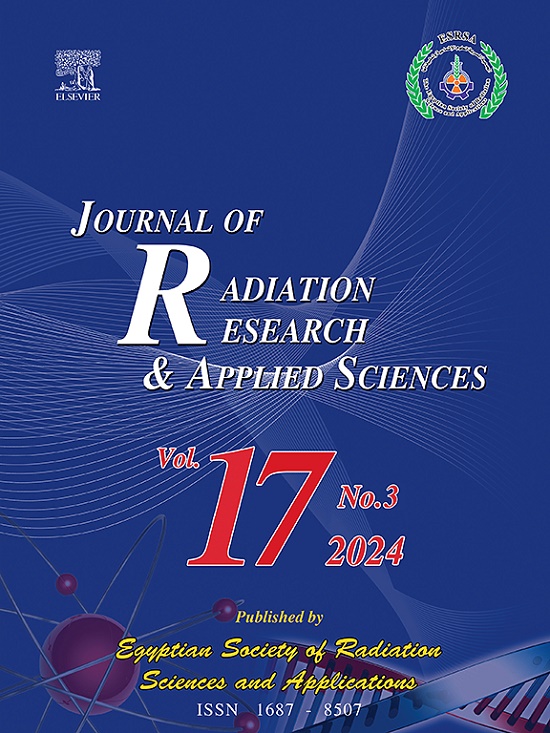Establishment of diagnostic reference levels based on administered radiopharmaceutical activity for adult and pediatric nuclear medicine procedures in Taif city, Saudi Arabia
IF 2.5
4区 综合性期刊
Q2 MULTIDISCIPLINARY SCIENCES
Journal of Radiation Research and Applied Sciences
Pub Date : 2025-08-15
DOI:10.1016/j.jrras.2025.101882
引用次数: 0
Abstract
Background
Nuclear medicine procedures are widely used in diagnostic imaging due to their ability to provide functional information about organs and tissues. However, these procedures involve exposure to ionizing radiation, which raises concerns about patient safety, particularly for vulnerable populations like children. Optimizing radiation doses has become essential to minimize unnecessary exposure while maintaining image quality.
Objective
This study aims to assess patient radiation doses (administered activities), propose local diagnostic reference level (DRLs) to both adult and paediatric patients in Taif, Saudi Arabia and estimate effective radiation doses (ED), associated with commonly performed nuclear medicine procedures.
Methodology
Data were collected from 277 adult and 60 pediatric patients who underwent nuclear medicine procedures at three NM centers in Taif City. Patient demographics (age, gender, weight, and height when available) and procedure-specific information were obtained from electronic medical records (EMR) and radiological information system (RIS). Administered radiopharmaceutical activities were the primary dose metric for DRL establishment which then converted to effective doses (mSv) using standard conversion factors from ICRP Publication 128. Descriptive analysis was conducted to calculate mean and median doses and propose local DRLs.
Results
The study found that adult procedures such as bone (HDP and MDP) and thyroid scans had mean effective doses of 3.54 mSv, 3.71 mSv, and 3.46 mSv, respectively, all within international standards. Paediatric renal MAG3 procedures showed wider variation depending on age, ranging from 0.35 mSv (1-year-old) to 2.5 mSv (10-year-old), while the DRL for aforementioned procedure was 740.770 and 185 MBq respectively, for adult and for paediatric renal MAG3 showed 40–185 MBq depending on age. Conclusion: Most procedures were within global safety benchmarks. However, elevated paediatric doses highlight the need for local DRLs and ongoing dose optimization. Implementing region-specific DRLs will improve protocol consistency, enhance safety, and support better-quality nuclear medicine services.
沙特阿拉伯塔伊夫市成人和儿童核医学程序中基于放射性药物活性的诊断参考水平的建立
核医学程序由于能够提供器官和组织的功能信息而广泛应用于诊断成像。然而,这些程序涉及电离辐射暴露,这引起了对患者安全的担忧,特别是对儿童等弱势群体。优化辐射剂量已成为必不可少的,以尽量减少不必要的暴露,同时保持图像质量。本研究旨在评估患者的辐射剂量(给药活动),为沙特阿拉伯塔伊夫的成人和儿科患者提出当地诊断参考水平(drl),并估计与常用核医学程序相关的有效辐射剂量(ED)。方法数据收集自塔伊夫市三家核医学中心接受核医学手术的277名成人和60名儿童患者。从电子病历(EMR)和放射信息系统(RIS)中获得患者人口统计信息(年龄、性别、体重和身高)和特定手术信息。给药放射性药物活动是DRL建立的主要剂量度量,然后使用ICRP第128号出版物中的标准转换因子转换为有效剂量(毫西弗)。描述性分析计算了平均和中位剂量,并提出了局部drl。结果研究发现,成人手术如骨(HDP和MDP)和甲状腺扫描的平均有效剂量分别为3.54毫西弗,3.71毫西弗和3.46毫西弗,均在国际标准范围内。儿童肾脏MAG3手术显示出更大的年龄差异,从0.35毫西弗(1岁)到2.5毫西弗(10岁)不等,而上述手术的DRL分别为740.770和185 MBq,成人和儿童肾脏MAG3手术的DRL根据年龄分别为40-185 MBq。结论:大多数程序符合全球安全基准。然而,儿科剂量升高突出了局部drl和持续剂量优化的必要性。实施针对特定区域的drl将提高协议的一致性,增强安全性,并支持更高质量的核医学服务。
本文章由计算机程序翻译,如有差异,请以英文原文为准。
求助全文
约1分钟内获得全文
求助全文
来源期刊

Journal of Radiation Research and Applied Sciences
MULTIDISCIPLINARY SCIENCES-
自引率
5.90%
发文量
130
审稿时长
16 weeks
期刊介绍:
Journal of Radiation Research and Applied Sciences provides a high quality medium for the publication of substantial, original and scientific and technological papers on the development and applications of nuclear, radiation and isotopes in biology, medicine, drugs, biochemistry, microbiology, agriculture, entomology, food technology, chemistry, physics, solid states, engineering, environmental and applied sciences.
 求助内容:
求助内容: 应助结果提醒方式:
应助结果提醒方式:


